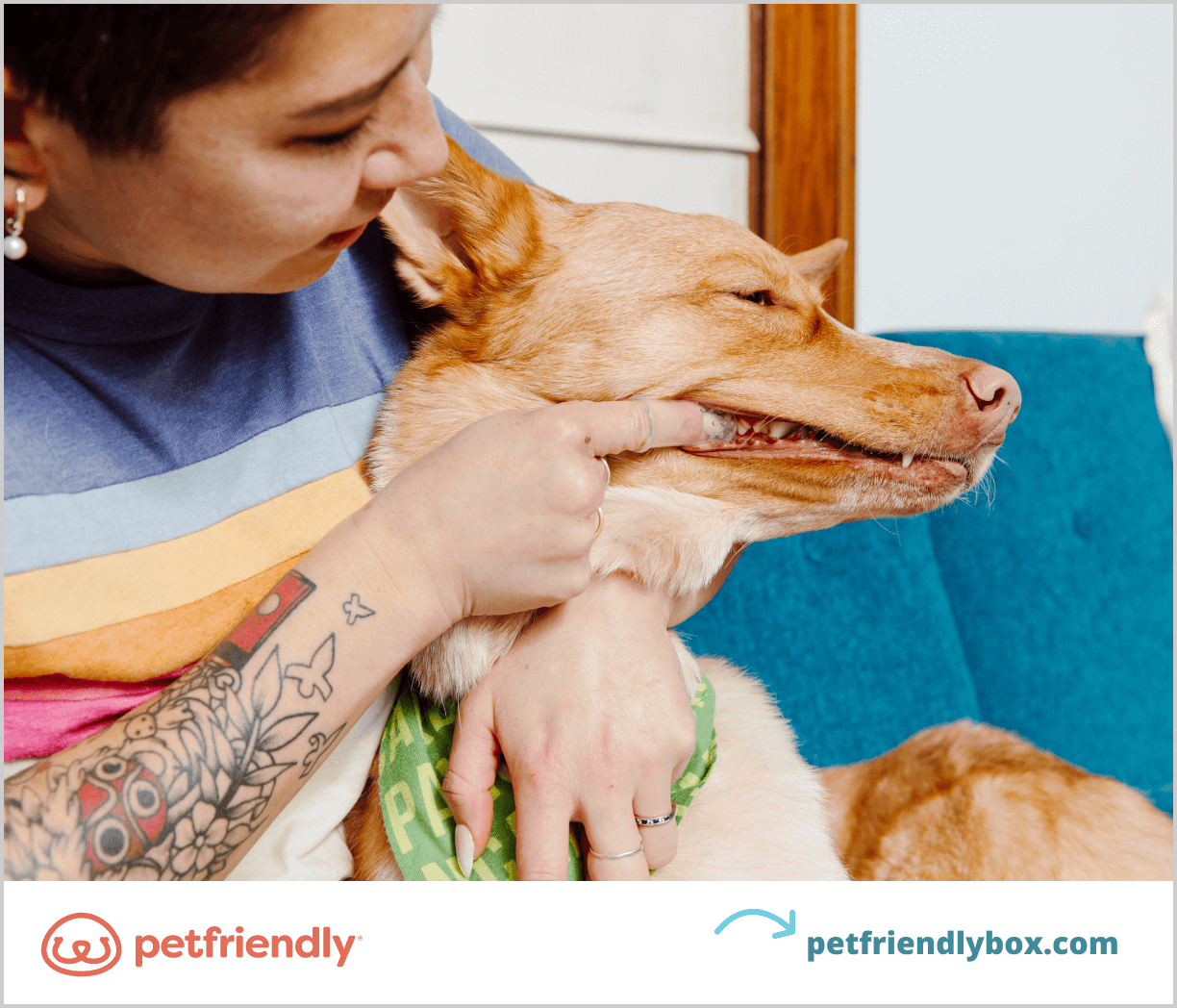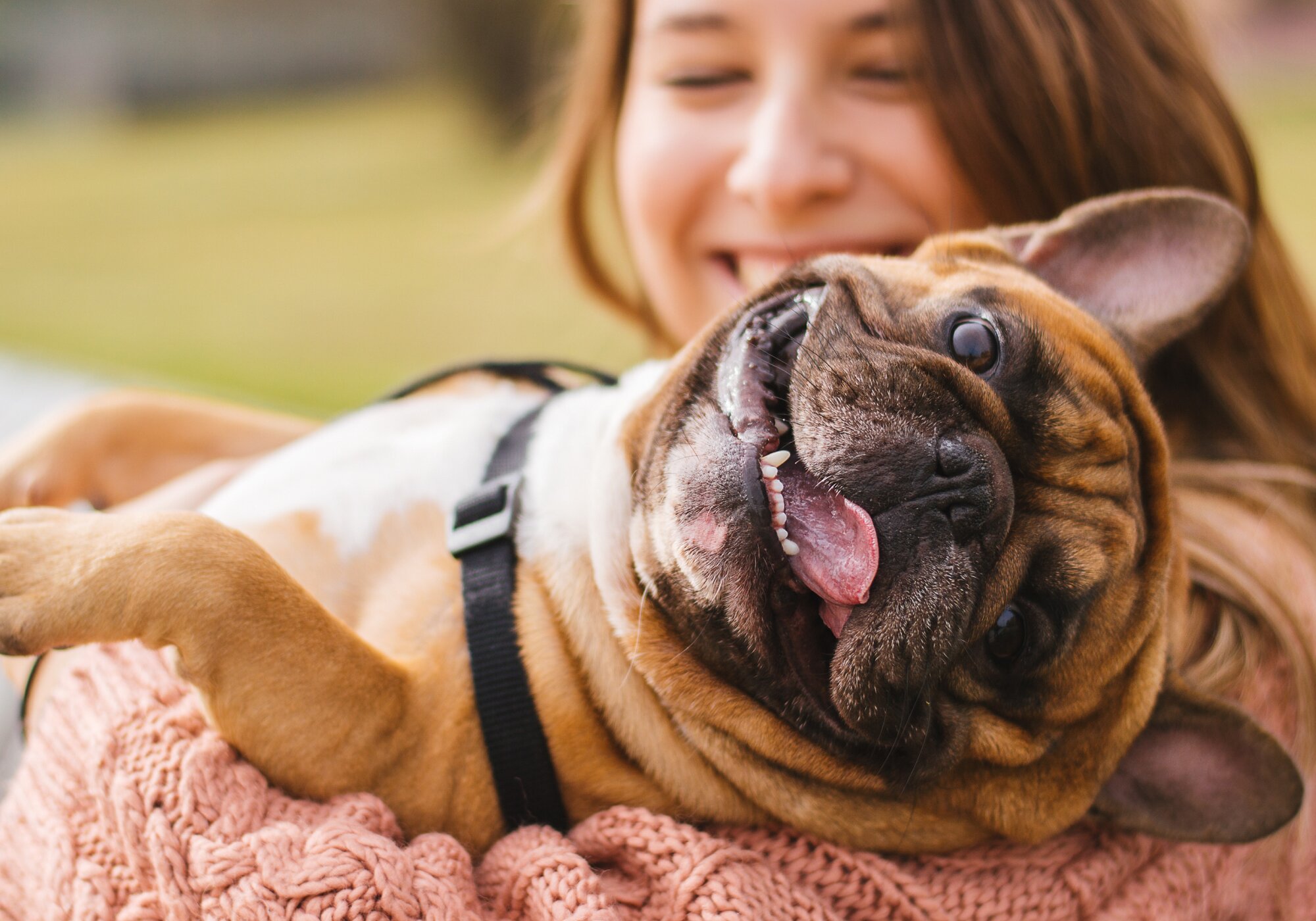Have you ever heard the saying, "A dog's mouth is cleaner than a human's?" Fortunately for humans, this isn't true. But, our mouths are a lot more similar to dogs than you may think.
Your dog's dental health starts with a clean mouth. The most effective way to ensure your dog's teeth are healthy and clean is through daily brushing.
Daily brushing might seem completely unrealistic and you might think brushing your dog's teeth isn't even necessary. But, it's totally possible and is one of the best ways to boost your dog's health and prolong their life.
Keep reading to learn:
- If dogs' teeth really need brushing
- Why teeth brushing is important
- When to start brushing your dog's teeth
- How often should you brush your dog's teeth
- Ways to tell if your dog needs dental care
- 7 tips for brushing your dog's teeth

Do dogs' teeth really need brushing

Dental hygiene is an essential component of your dog's health. Without clean teeth, your dog may avoid eating their food, chewing toys, and exercising. These all help them stay healthy and contribute to a long, happy life.
Unfortunately, many pet parents do not brush their dog's teeth. A study by Ipsos found that only 7% of dog owners take part in daily brushing. And another found that 70% of dog owners have never brushed their teeth. That's a lot of unclean dog mouths.
Why is tooth brushing important

More serious health problems can also show up as a result of poor dental health. In fact, more than two-thirds of dogs get periodontal disease before the age of three.
Brushing your dog's teeth is the best way to:
- Prevent dental disease
- Promote good breath
- Support long-term dental health
What happens if I don't brush my dog's teeth?
If you avoid brushing your dog's teeth on a regular basis it could lead to gum disease, dead teeth, and more. All of which you cannot remedy at home.
Your veterinarian should monitor your dog's dental health problems so they can determine the best course of action. But, to prevent any dental disease altogether, brushing your dog's teeth is a good idea.

When to start brushing your dog's teeth
Right away, especially if you have a puppy. It’s much easier to train your dog to love tooth brushing when they are young. Many pet parents skip teeth brushing because it's messy and dogs typically don't like unwanted objects in their mouths. And depending on the condition of your dog's teeth it could cause them a little pain.
If tooth brushing is new to you, don't stress. Convincing your adult or senior dog to allow you to brush their teeth can be difficult. Be patient, take your time, and don't give up. Many dogs accept the tooth-brushing process over time.
Is it too late to start brushing my dog's teeth?
Starting tooth brushing early will definitely make it easier to maintain your dog's dental care. But, this shouldn't stop you from working on it at any age. Dogs of all ages can benefit from a regular tooth-brushing routine to avoid dental disease.
How often should you brush your dogs' teeth

You may be wondering, "How often should I brush my dog's teeth?" Knowing how often to brush your dog's teeth isn't rocket science. Experts recommend at least two to three times per week at the least.
This cadence helps many pet owners:
- Identify health problems
- Remove plaque and tartar
- Protect the gum line
- Boost their dog's oral health
It may feel totally unrealistic to brush your dog's teeth every day. So getting your puppy into a regular routine right away will be helpful in the long run. The sooner your dog accepts having a finger or two in their mouth the better.
Is brushing my dog's teeth once a week enough?
To really keep plaque and tartar buildup at bay and avoid periodontal disease, experts recommend daily tooth brushing. But, many pet parents simply don't have the time.
Here's a good schedule for keeping your dog's teeth clean and healthy:
- Daily: If you can't brush your dog's teeth on a daily basis give them dental treats or chews. Your dog will gnaw on the chew which can help remove plaque and tartar.
- Weekly: Experts recommend brushing your dog's teeth for one minute, two to three times per week. But, even once a week will help you prevent dental disease.
- Annually: In addition to a weekly routine, your vet may recommend professional teeth cleanings. These are usually annually and can be a part of their yearly dog check-up.
Is it okay if I don't brush my dog's teeth?
The reality is, nothing replaces brushing your dog's teeth. But if you're not keen on teeth brushing, there are a few other options to consider:
- Your vet. One option is to have your veterinarian clean your dog's teeth. They'll do a great job and can keep an eye out for more serious health problems. But, routine visits to your vet can get expensive and may be hard to schedule.
- Professional groomers. Some grooming salons offer dental cleaning services for your dog. This is a convenient option if you get your dog groomed regularly. But, they won't be able to give your pet's mouth a deep clean the way a medical professional or DVM can.
Professional teeth cleaning can be totally routine or complex and expensive. It's all dependent on your dog's dental health.
Typical cleanings look like this:
- (When needed) Your dog receives general anesthesia.
- Your veterinarian will conduct a thorough oral exam
- Vets and vet techs will help clean and polish their teeth
- Depending on the severity, they may extract teeth
The cost of professional dental care is dependent on your pet's age, weight, and the use of general anesthesia. Typical cleanings range from $50-$300. But, if your dog has dental disease, this can quickly increase to $500 or more.
General anesthesia might seem scary. But, sedation helps your veterinarian clean your dog's teeth more effectively. It also reduces stress and pain for your pet.
If your pet needs x-rays, sedation will help keep your dog still. That way your vet can capture a clear image of their mouth and jaw.

Ways to tell if your dog needs dental care

There are several ways a DVM (doctor of veterinary medicine) will tell if your dog needs professional care. The most common signs of poor oral health are:
- Discolored teeth from plaque and tartar
- Bad breath (Halitosis)
- Bloody gums or blood in their water bowl
- Severe infections
- Reduced or loss of appetite
- Pain or discomfort while eating
- Sore or swollen gums and face
- Thick, excessive saliva
- Periodontal disease
Signs and symptoms of periodontal disease
Periodontal disease (or gum disease) is fairly common in dogs by the age of three. Periodontal means the "disease that affects the structures that support the teeth" — aka the gums and gum line.
When your dog's teeth don't receive proper dental care, plaque will harden into tartar which is difficult to remove. If it resides below the gum line it can be damaging for your pet and lead to periodontal disease.
Some common signs and symptoms of periodontal disease include:
- Plaque and tartar buildup
- Gingivitis (red, bloody, swollen gum line)
- Bone or gum loss around the teeth
- Tooth loss or decay (broken or loose teeth)
- Discolored teeth (brown or yellow)
- Pain and discomfort
- Weight loss or decreased appetite
- Excess, bloody, or thick saliva
The biggest concern with periodontal disease in dogs is bacteria. Bacteria that live in your dog's mouth untouched can make their way to your pet's bloodstream. This can lead to other health problems for internal organs like the kidneys, heart, and liver.

How to brush your dog's teeth

Taking your dog to your veterinarian or a professional groomer to clean their teeth might be your preference. And for most pet parents this is certainly the case. If you want to take your dog's dental care into your own hands it's totally doable.
Here are 7 expert tips for making tooth brushing a positive experience for your dog.
1. Set up a calm, safe space.
If your pet isn't familiar with regular teeth cleaning, you'll want to make sure they feel safe and comfortable. This is especially true if you have a new puppy.
Set up a cozy spot with their favorite blankets and toys. If necessary, enclose the space with a playpen, crate, or kennel and have lots of dog food or treats on hand.
Training your dog to visit this spot two to three times a week can make your tooth-brushing routine even easier. Especially if they don't have to get their teeth brushed there every time.
2. Get a friend or family member to help.
Most pet owners know that taking care of a pet can be overwhelming if you have to go it alone. Plus, teeth cleaning can feel scary and threatening to your dog. As a result, many dogs get aggressive or squirm as you try to clean.
Grab another human that your dog is familiar with to help hold their head so you can focus on their teeth. If you have a small dog, have your friend hold them in their lap. Otherwise, have your human helper sit behind your dog and give them a bear hug.
3. Gather the right supplies.
You and your dog's mouth have many similarities. But, you should not use human toothpaste or other human supplies to brush your dog's teeth. Dog tooth enamel is much thinner than humans so using the same supplies can actually harm your pet.
Here are a few tips to prepare to brush your dog's teeth:
- Look for dog-specific toothpaste. The best dog toothpaste contains enzymes that help fight plaque and tartar. Many have chicken or beef flavoring which helps encourage your dog to lick the paste. Do not use human toothpaste on your dog's teeth.
- Find a long-stem dog toothbrush or finger brush. Human toothbrushes are too short for dogs and are often easy to chew by your dog. Dog toothbrushes have long stems and short heads. This helps you reach those back molars.
- Be cautious of home remedies. In a pinch, home remedies made with baking soda may seem like a positive choice. But, baking soda and chicken broth concoctions can cause stomach upset for your dog.
- Lookout for toxic ingredients. Xylitol is an ingredient found in human toothpaste. It is toxic to dogs and can be fatal. Human toothpaste also contains a lot of sodium and baking soda which can create stomach problems for your dog.
4. Start slow.
Before you start brushing, allow your dog to get familiar with human fingers in their mouth. Once they accept that you'll be in their business a little more, tooth brushing will be a breeze.
Start with a cloth, dental wipe, or simply your finger to explore your dog's mouth. Reassure your pet along the way with dog food, treats, and positive reinforcement. Don't be afraid to start the process over if your dog shows signs of anxiety or stress.
Then, ease your dog into the process by introducing the supplies you'll be using to brush their teeth. Allow them to smell, taste, and inspect everything so they don't get frightened. Orienting the tools you'll be using on a regular basis will help your puppy accept treatment more easily in the future.
5. Begin at the gum line.
When you're ready to start brushing, gently lift their lips with your fingers. Place the dog toothbrush or fingerbrush at the top of their canines. This is where plaque and tartar tend to build up the most.
Start at the gum line and work your way down and forward. As your dog gets more comfortable, move your finger or toothbrush further back to their molars. Be sure to get the outer surface and bottom of the teeth.
Don't worry about your dog's tongue or the inside of their teeth, especially if they are getting fussy or aggressive. Most periodontal damage shows up on the surface of their teeth.
Brushing should only take you a minute or two. Spend at least 30 seconds on each side and repeat this process daily after their meals.
6. Supplement brushing with daily treats.
Unlike humans, who eventually develop the skills to brush on their own, dogs need your help to brush their teeth. And as pet parents, you want the best for your pets.
But, with busy schedules and full days, it can be hard to take care of your dog's dental health every week. Or, simply find the time to brush often enough.
One natural way for dogs to clean their teeth is through regular chewing. If you can't brush your dog's teeth daily there are other products that you can use to supplement brushing.
Keep a stash of these dental products on hand to keep your dog's teeth healthy:
Dental chews: There are a few different types of dental chews to choose from. Most have potato starch or rawhide which are tough to chew, but easy to digest. They help scrape away plaque and tartar that contribute to gum disease.
Dental treats: Like chews, dental treats are bite-sized alternatives for your dog. Treats are usually safe for daily or weekly use and have a familiar treat taste. They come in many shapes and sizes that seem like normal dog treats.
Bones or antlers: Dog bones, antlers, and rawhides are also helpful ways to scrape plaque and tartar from your dog's teeth. Bones are a great alternative for dogs who love to chew. But, keep a close eye so they don't swallow any pieces whole.
Chew toys: There are tons of dental chew toys that can also help with teeth brushing. Made of plastic, rubber, or nylon, they help scrape away plaque and tartar on the surface of your dog's teeth.
Dental gel: If your dog isn't much of a chewer, dental gel might be a good alternative for you. Dental gels are an oral treatment applied directly to your dog's gums. Some allow you to apply with your finger and others have built-in applicators. You can also put it on dental chews or treats.
Dental wipes and finger sleeves: Wipes are great for dogs who are a little more skeptical about teeth cleaning. They typically come with a medicated solution applied when you wipe the surface of the tooth. But, they aren't super effective at cleaning out small spaces between the teeth.
Water additives: This supplement is exactly as it sounds, brush-free and little-to-no taste. Water additives are solutions to add to your dog's water. They have enzymatic ingredients that help break down plaque and tartar and promote good breath.
Food: Tons of fruits, vegetables, and animal proteins can promote good dental health in your pet. Some great natural treats for your dog's teeth include raw meaty bones, celery, carrots, strawberries, and blueberries. Try freezing these items for a healthy summer dental treat.
7. Practice regularly.
Brushing can easily become a regular part of your dog's training and grooming routine with a little practice. It's a good idea to include brushing in training to help dental cleanings feel more normal for your dog. The more often you clean, the easier it will be.
Pet parents can practice brushing their dog's teeth at any age. Just remember, the tooth-brushing process can be slow and arduous. Be patient and know you're supporting your dog's health.

Now that you know how often you should brush your dog's teeth, it's time to make it a priority. You don't have to be a professional to brush your dog's teeth. And the reality is, oral health plays a big part in your pet's overall health and well-being.
With the right supplies, space, and steps you can take care of your pet's oral health pain and stress-free. Looking for a supplement to your daily brushing routine? Explore our unique, dental stick for dogs.

